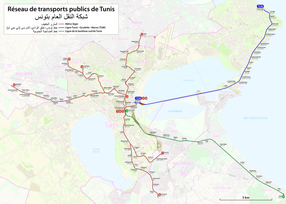Tunis light rail
| Tunis light rail | |
|---|---|
| Multiple unit type Hannover of the Tunis light rail | |
| Basic information | |
| Country | Tunisia |
| city | Tunis |
| opening | 1985 |
| operator | Société des transports de Tunis |
| Infrastructure | |
| Route length | 45 km |
| Gauge | 1435 mm ( standard gauge ) |
| Power system | 750 V DC overhead line |
| Stops | 66 |
| business | |
| Lines | 6th |
| vehicles | 136 Siemens TW 6000 , 30 Alstom Citadis |
| Line network 2019 | |
The Tunis light rail (literally: light Métro (of the city) Tunis , French Métro léger de Tunis , Arabic المترو الخفيف لمدينة تونس - al-Mītrū al-chafīf li-Madīnat Tūnis) is a light rail network in the greater Tunis area that went into operation in 1985 , the capital of Tunisia . The network is around 45 kilometers long and includes 6 lines and 66 stations. It is operated by the Société des transports de Tunis (also called Transtu), the public transport company responsible for public transport in the greater Tunis area. The Tunis light rail, after that of Heliopolis , is the first of its kind on the African continent .
history
First tram network
A horse-drawn tram has operated in Tunis since 1885. In 1900 the first electric tram opened. As a result, the electric tram network was continuously expanded until the greatest route length of 30 kilometers was reached in 1935 . In 1945 the first tram lines were shut down and replaced by trolleybuses . Over the next 20 years, the network was gradually thinned out until the last two tram lines were shut down on April 20, 1960. These were line 3 to Le Bardo and line 4 to Manouba. Only ten years later, the trolleybus traffic was also stopped again.
New light rail network
Basic network
Tunis was the first city in Africa to put a modern light rail system into operation. The systems were built by Siemens AG, the vehicles were high-floor railcars that were built by Duewag based on the Hanoverian TW 6000 . Line 1 Tunis Marine ↔ Ben Arous with a length of 9.5 kilometers was put into operation as the first route on October 13, 1985 . On November 7th, 1989 the line 2 Place de Barcelone ↔ Ariana followed with a length of 8.9 kilometers. Line 3 Place de Barcelone ↔ Les Jasmins was put into operation together with line 4 Tunis Marine ↔ Bardo on July 25, 1990. In September 2009, the 5 Place de Barcelone ↔ Intilaka line opened . In July 1994, line 3 was extended beyond Les Jasmins to Ibn Khaldoun . On March 27, 1995, line 4 was also extended beyond Bardo to Den Den . The basic network commissioned by Siemens was now fully operational. Due to the high development in demand, it soon became apparent that the existing 78 railcars would not be sufficient. Therefore, not only had additional wagons to be procured, but a second depot also had to be built.
Expansion from 2001
In addition to the large increase in passengers on the existing lines, there was also the desire to expand the network in order to be able to connect the El Mourouj district with more than 100,000 inhabitants. For this purpose, a branch line was built from the Mohamed Ali stop on line 1. The first section to El Montazah was opened on August 11 , 2008, and the entire line to El Mourouj went into operation on November 8, 2008. For this new route, Tunis turned away from high-floor light rail vehicles and instead placed an order with Alstom for the delivery of 30 low-floor trams. Because of their entry height of 35 centimeters, the elevated platforms were dismantled again. Only low-floor wagons operate on the new line 6. On December 10, 2009, line 4 was extended by eight stops from Den Den to Manouba University ( Kheireddine stop ).
vehicles
Between 1984 and 1997 DUEWAG delivered 136 multiple units of the Hannover type to Tunis. In 2004, a decision was made to purchase 30 new Citadis trains from Alstom to supplement them . The 32-meter-long, five-part multi-articulated Citadis 302 vehicles have been in use since the end of 2007. They only have one driver's cab and generally operate rear-to-rear in double traction.
See also
literature
Jens Perbandt: With high and low floor through Tunis . Tunisia: City and S-Bahn in Tunis continue to grow. In: Tram magazine . No. 5 , 2011, p. 52-55 .
Web links
Individual evidence
- ↑ cityrailtransit.com : Tunis Real Distance Metro Map. Retrieved June 19, 2011 .
- ↑ La Presse : Un tramway nommé plaisir. (No longer available online.) September 18, 2007, formerly in the original ; Retrieved June 19, 2011 . ( Page no longer available , search in web archives ) Info: The link was automatically marked as defective. Please check the link according to the instructions and then remove this notice.





